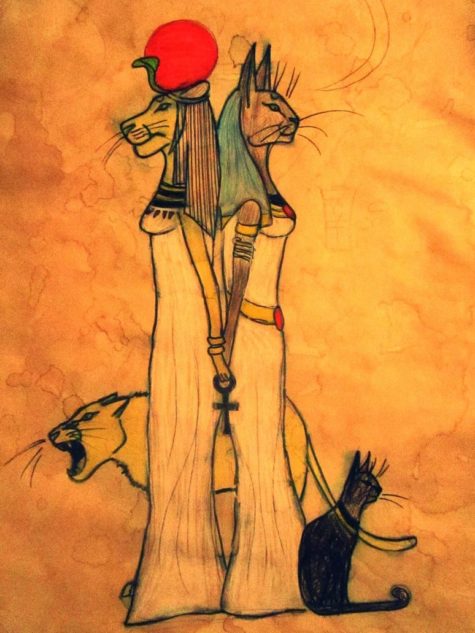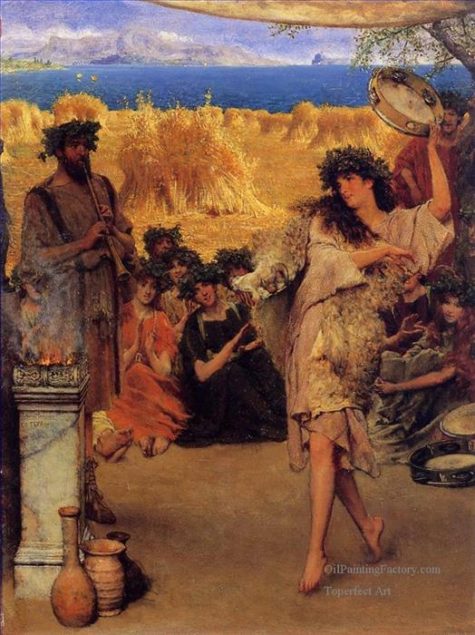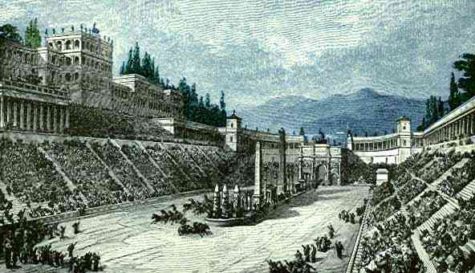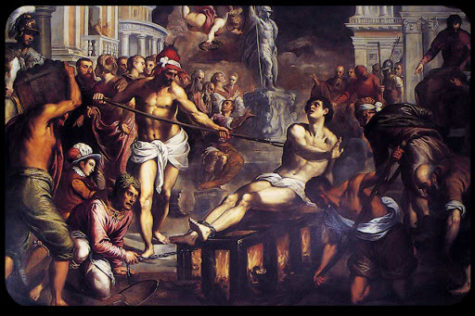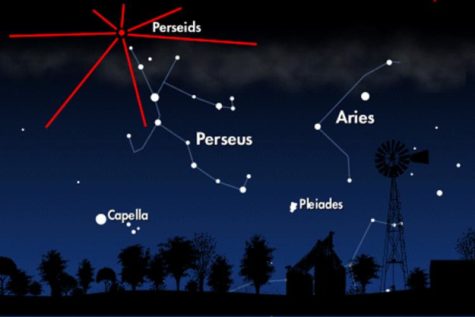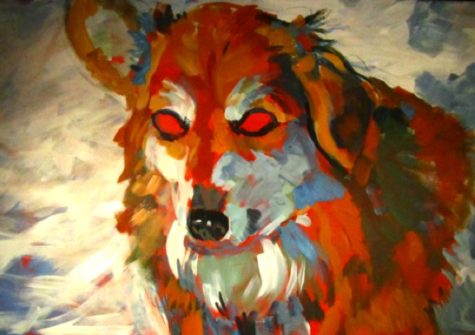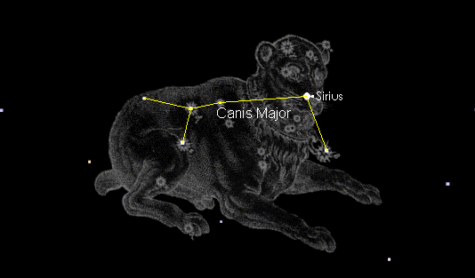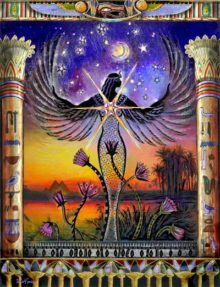August
Bread is a central feature in Lammas and Lughnasadh celebrations. Here’s a great recipe for whole grain bread:
In a large mixing bowl combine:
- 2 cups milk (warm to the touch)
- 2 packages of dry baking yeast
- 1 teaspoon salt
- 1/2 cup honey
- 1/4 cup dark brown sugar
Cover this mixture and set aside in a warm place until it has doubled (about half an hour). Add to this mixture:
- 3 tablespoons softened butter
- 2 eggs
- 1 cup of unbleached white flour
Stir until bubbly. Now mix in:
- 1/2 cup wheat germ
- 1/2 cup of rolled oats
- 2 cups stone ground wheat flour
- 2 tablespoons sesame seed
With floured hands, turn this dough out onto a floured board and gradually knead in more unbleached white flour until the dough is smooth and elastic and no longer sticks to your fingers.
Place this dough in a greased bowl, turning it so that the dough is greased. Then cover it with a clean cloth and keep it in a warm place to rise until it is doubled (about an hour).Then punch it down and divide it into two or more elongated loaves, roughly sculpted into mummiform shapes, and placed on greased cookie sheets.
Cover these and return them to a warm place until they double again. Bake the loaves in a pre-heated oven at 350 degrees for about an hour, or until they are done and sound hollow when tapped.
In ancient Egypt, the saving of mankind was commemorated every year on the feast day of Hathor/Sekhmet (Jan 7). Everyone drank beer stained with pomegranate juice and worshiped
“the Mistress and lady of the tomb,
gracious one,
destroyer of rebellion,
mighty one of enchantments“
A statue of Sekhmet was dressed in red facing west, while Bast was dressed in green and faced east. Bast was sometimes considered to be Sekhmet´s counterpart (or twin depending on the legend), and in the festival of Hathor they embodied the duality central to Egyptian mythology. Sekhmet represented Upper Egypt while Bast represented Lower Egypt.
- Note:
The dates for this feast day vary widely. In the book, Festivals of Light, August 7 is given as the Inebriety of Hathor, with a similar description of the festivities.
August 25th is the Opconsivia, (or Opeconsiva or Opalia) the harvest festival of Ops, the Roman goddess of agricultural resources and wealth, also known as Opis. The festival marked the end of harvest, with a mirror festival on December 19 concerned with the storage of the grain.
- Themes: Opportunity; Wealth; Fertility; Growth
- Symbols: Bread; Seeds; Soil
About Ops: This Italian goddess of fertile earth provides us with numerous “op-portunities” to make every day more productive. In stories, Ops motivates fruit bearing, not just in plants but also in our spirits. She also controls the wealth of the gods, making her a goddess of opulence! Works of art depict Ops with a loaf of bread in one hand, and the other outstretched, offering aid.
To Do Today:
On this day, Ops was evoked by sitting on the earth itself, where she lives in body and spirit. So, weather permitting, take yourself on a picnic lunch today. Sit with Ops and enjoy any sesame or poppy breadstuff (bagel, roll, etc.) – both types of seeds are magically aligned with Ops’s money-bringing power. If possible, keep a few of the seeds from the bread in your pocket or shoe so that after lunch, Ops’s opportunities for financial improvements or personal growth can be with you no matter where you go. And don’t forget to leave a few crumbs for the birds so they can take your magical wishes to the four corners of creation.
If the weather doesn’t cooperate, invoke Ops by getting as close to the earth as you can (sit on your floor, go into the cellar). Alternatively, eat earthy foods like potatoes, root crops, or any fruit that comes from Ops’s abundant storehouse.
More About This Festival:
The Latin word consivia (or consiva) derives from conserere (“to sow”). Opis was deemed an underworld goddess who made the vegetation grow. Since her abode was inside the earth, Ops was invoked by her worshipers while sitting, with their hands touching the ground.
Although Ops is a consort of Saturn, she was also closely associated with Consus, the protector of grains and subterranean storage bins (silos). The festival of Consus, the Consualia, was celebrated twice a year, each time preceding that of Ops: once on August 21, after the harvest, and once on December 15, after the sowing of crops was finished.
The Opiconsivia festival was superintended by the Vestals and the Flamines of Quirinus, an early Sabine god said to be the deified Romulus. The main priestess at the regia wore a white veil, characteristic of the vestal virgins. A chariot race was performed in the Circus Maximus. Horses and mules, their heads crowned with chaplets made of flowers, also took part in the celebration.
Sources: Wikipedia and 365 Goddess
On August 21, the ancient Romans celebrated the Consualia, a festival, with games, in honour of Consus, the god of secret deliberations.
It was solemnized every year in the circus, by the symbolical ceremony of uncovering an altar dedicated to the god, which was buried in the earth. This was because Romulus, who was considered the founder of the festival, was said to have discovered an altar in the earth on that spot.
The solemnity took place on the 21st of Augusta with horse and chariot races, and libations were poured into the flames which consumed the sacrifices. During these festive games, horses and mules were not allowed to do any work, and were adorned with garlands of flowers.
This festival is associated with the “Rape of the Sabine Women.” When after the building of Rome the Romans had no women, it is said, and when their suit to obtain them from the neighboring tribes was rejected, Romulus spread a report, that he had found the altar of an unknown god buried under the earth. The god was called Consus, and Romulus vowed sacrifices and a festival to him, if he succeeded in the plan he devised to obtain wives for his Romans. According to legend, it was at the first celebration of the Consualian Games that the Sabine maidens were carried off. The purpose being to populate the newly built town of Rome.
Note: Consus was eventually identified with Neptunus Equester, the alias and counterpart of Poseidon Hippios (Neptune), who was the founder of Atlantis, where, according to Plato, horses (hippos, equus) originated. Hence the connection with the animal.
When told by Roman officials to surrender the church’s valuables, St. Lawrence brought the city’s poor and sick. “Here is the church’s treasure,” he said.
Rome didn’t find this amusing, and legend says he was put to death in A.D. 258 by being roasted on a grate, although some scholars say he was more likely beheaded. In either case, folks in southern Europe still mark this day.
- It is customary there to eat only cold meat in recognition of the reputed manner of his death.
- Fair weather on St. Lawrence’s Day presages a fair autumn.
To do on Saint Lawrence’s Day:
Tonight, or especially tomorrow night and up to the dawn of August 12, if you look up at a clear sky in the Northern hemisphere, you may be blessed to see the Perseids meteor shower. This meteor shower is known as “the tears of St. Lawrence” because it is most visible at this time of year, though these streaks of light can sometimes be seen as early as 17 July and as late as 24 August.
To see St. Lawrence’s “fiery tears,” go outside after midnight, to a place as far away as possible from city lights (leave the city, if possible, and drive toward the constellation so that the city lights’ glow will be behind you). Lie down on the grass and look up and toward the North, about halfway between the constellation Perseus 3 — which will be very, very low on the horizon to the northeast — and the point directly overhead. Scan the sky elsewhere, too, but this area will be the most likely place to see the meteors.
If the sky is too cloudy or the Moon is too full for you to get a good view of the stars, you might not have any luck at all — but there will always be next year to try again!
When you see a “shooting star,” make a wish, as folklore says that wishes made when seeing such a star come true. Better yet, make the “wish” a prayer, and invoke St. Lawrence to pray it with you!
The darkness is no darkness with me,
but the night is as clear as the dawning,
that shineth more and more unto the perfect day.
~Saint Lawrence
As to foods, aside from the European custom of eating only cold meat, there is nothing else in particular associated with this day that I am aware of. However, given St. Lawrence’s mode of death, a barbecue might make for an interesting choice. Grill some meats and vegetables, have a nice cooler of beer, and prepare for a late night of star-gazing and recalling the glory of St. Lawrence! Continue reading
Get set for the meteoritic grand finale of summer. The middle week of August is the peak of the Perseid meteor shower.
The Perseids is one of the best meteor showers to observe, producing up to 60 meteors per hour at its peak. It is produced by comet Swift-Tuttle, which was discovered in 1862. The Perseids are famous for producing a large number of bright meteors. The shower runs annually from July 17 to August 24. Best viewing will be from a dark location after midnight. Meteors will radiate from the constellation Perseus, but can appear anywhere in the sky.
It peaks this year (2017) on the night of August 12 and the morning of August 13. The waning gibbous moon will block out many of the fainter meteors this year, but the Perseids are so bright and numerous that it should still be a good show.
Of course, like with any meteor shower, it’s worth starting to watch a few days prior to the peak date. Although meteor streams like the Perseids have been modeled and mapped over the years, there are still lots of surprises out there. Plus, starting an early vigil is insurance that you at least catch some action in the event that you’re clouded out on game day! The Perseids are already active, spanning a season from July 17th to August 24th.
Here’s a sky map:
Source: SeaSky and other sources
The Delta Aquarids is an average meteor shower that can produce up to 20 meteors per hour at its peak. It is produced by debris left behind by comets Marsden and Kracht. The shower runs annually from July 12 to August 23. Best viewing will be from a dark location after midnight. Meteors will radiate from the constellation Aquarius, but can appear anywhere in the sky.
Source: SeaSky
“These are strange and breathless days,
the dog days, when people are led to do things they are sure to be sorry for after.”
The Dog Days originally were the days when Sirius rose just before or at the same time as sunrise, which is no longer true, owing to procession of the equinoxes.
The Old Farmer’s Almanac lists the traditional period of the Dog Days as the 40 days beginning July 3rd and ending August 11th, coinciding with the ancient heliacal (at sunrise) rising of the Dog Star, Sirius. These are the days of the year with the least rainfall in the Northern Hemisphere.
These canicular days get their name from the Dog Star, Sirius, the brightest star in the constellation Canis Major. At this time of the year Sirius disappears into the Sun’s glow. Both heavenly bodies are in conjunction, rising and setting at around the same time. Ancient stargazers thought that the heat from Sirius, the brightest star in the heavens, combined with the heat of the Sun produced the hottest weather of the year! Even though Sirius is hotter than our Sun it is much too far away to warm our planet.
In Ancient Rome, the Dog Days ran from July 24th through August 24th, or, alternatively, from July 23 through August 23rd. The period was reckoned as extending from 20 days before to 20 days after the conjunction of Sirius (the dog star) and the sun.
The Romans sacrificed a brown dog at the beginning of the Dog Days to appease the rage of Sirius, believing that the star was the cause of the hot, sultry weather. In many European cultures (German, French, Italian) this period is still said to be the time of the Dog Days.
Since its rising also coincided with a time of extreme heat, the connection with hot, sultry weather was made for all time:
“Dog Days bright and clear indicate a happy year.
But when accompanied by rain, for better times our hopes are vain.”
The ancient Egyptians saw Sirius as a giver of life for it always reappeared at the time of the annual flooding of the Nile. When the star sank in the west and disappeared from the night sky, it remained hidden for 70 days before emerging in the east in the morning. This was viewed as a time of death and rebirth. The Egyptians copied this period in their funeral ceremonies. When a king died, his body was mummified, then interred in a pyramid or other tomb. By custom, burial took place 70 days after death, when the king was “reborn” in the stars.
Sirius was astronomically the foundation of their entire religious system. It was the embodiment of Isis, sister and consort of the god Osiris, who appeared in the sky as Orion. This is the period of time Sirius disappears from the sky — sequenced in the myth when Isis is hiding until the birth of her son, Horus — eventually the star reappears after Horus is born — resurrection.
On the first day of Sirius’ reappearance the ancient Egyptians expected an abundant harvest, if the star appeared bright and clear. If Sirius appeared dull and red, a poor harvest would result.
The Dog Star, Sirius is also known as our Spiritual Sun, esoterically the cosmic heart of our physical Sun. During the Dog Days when Sirius disappears into the Sun’s glowing light, it could be said that our physical Sun is embracing our Spiritual Sun! After such a celestial union a rebirth or resurrection can be expected.
Dog Days were popularly believed to be an evil time according to Brady’s Clavis Calendaria, 1813:
“the Sea boiled, the Wine turned sour, Dogs grew mad, and all other creatures became languid; causing to man, among other diseases, burning fevers, hysterics, and phrensies.”
The 1552 edition of the The Book of Common Prayer, way the “Dog Daies” begin July 6th and end August 17th. This corresponds very closely to the lectionary of the 1611 edition of the King James Bible (also called the Authorized version of the Bible) which indicates the Dog Days beginning on July 6th and ending on September 5th.
Note:
A recent reprint of the 1662 edition of the Book of Common Prayer contains no reference to the Dog Days. In the Southern Hemisphere, they typically occur in January and February, in the midst of the austral summer.
Honoring the Dog Days
- Themes: Fertility; Destiny; Time
- Symbols: Stars; Dogs
- Presiding Goddess: Sopdet
About Sopdet:
The reigning Egyptian Queen of the Constellations, Sopdet lies in Sirius, guiding the heavens and thereby human destiny. Sopdet is the foundation around which the Egyptian calendar system revolved, her star’s appearance heralding the beginning of the fertile season. Some scholars believe that the Star card of the tarot is fashioned after this goddess and her attributes.
Note: The dog days and the dog star Sirius are also associated with the Egyptian Goddess Hathor..
To Do Today:
The long, hot days of summer are known as “dog days” because they coincide with the rising of the dog star, Sirius. In ancient Egypt this was a welcome time as the Nile rose, bringing enriching water to the land. So, go outside at dawn, and welcome the Sun. Make an offering of water, and whisper a wish to Sopdet suited to her attributes and your needs. For example, if you need to be more timely or meet a deadline, she’s the perfect goddess to keep things on track.
If you’re curious about your destiny, watch the eastern region of the sky in the evening and see if any shooting stars appear. If so, this is a message from Sopdet. A star moving on your right side is a positive omen/ better days ahead. Those on the left indicate a need for caution, and those straight ahead mean things will continue on an even keel for now.
Nonetheless, seeing any shooting star means Sopdet has received your wish.
Source: Wikipedia and Almanac.com and 365 Goddess

